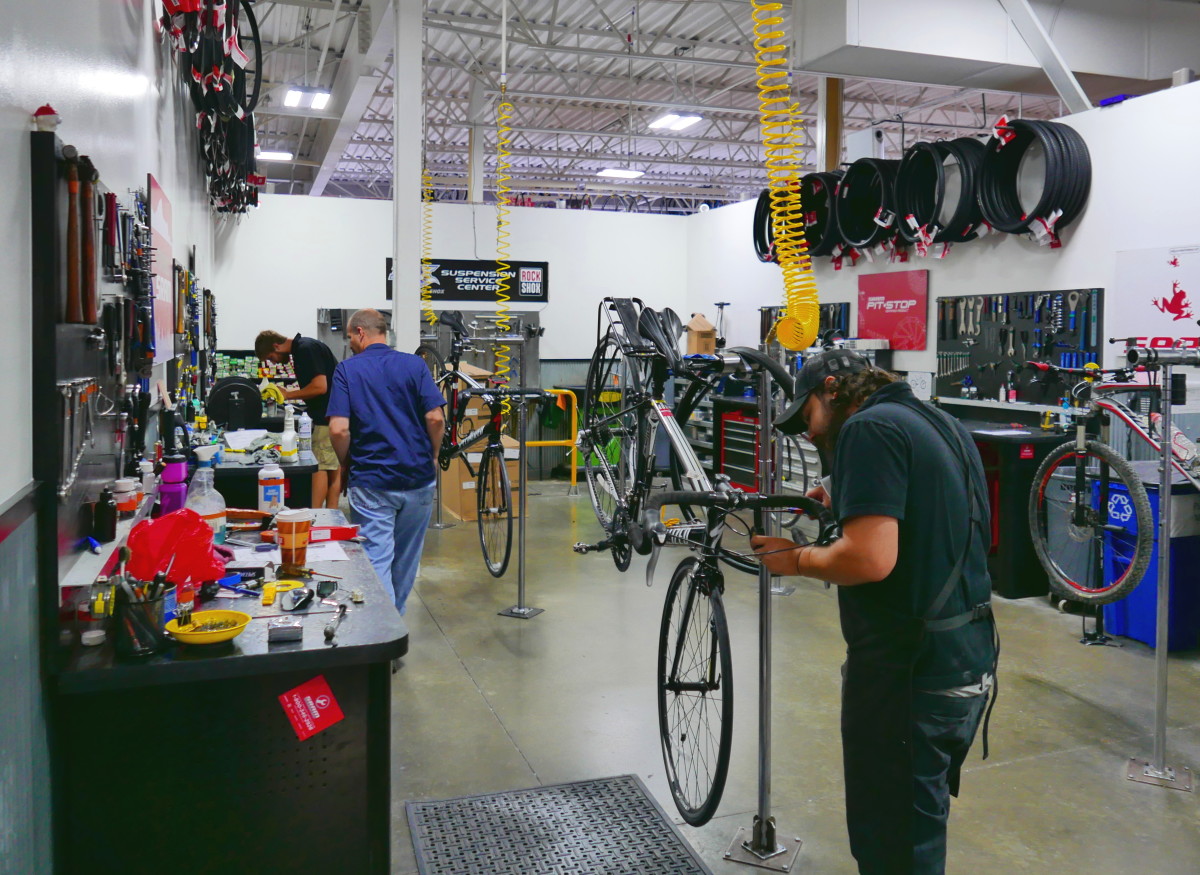
Your bike is hurting on the inside. And it may just decide to lay down on the job.
Even if Travis Stephens didn’t say that – or even think it – there’s a chance it’s true. A little, anyway. And it doesn’t matter how much you paid for it. It only matters how much you care for it after you paid for it. And how many times you slam it into rocks, bounce it over roots, or launch it off of jumps without tending to its bits and pieces. Let’s not even get into the sand you’ve ridden through that is, at this very moment, worming its way into every little vulnerable nook and cranny.
Of course, if you’re one of those people, constantly cleaning, tinkering, adjusting, turning wrenches, and dialing in every little thing, then you’re bike is probably not anywhere near hurting.
I’m not that guy. My bikes are always in various states of hurt. And that’s why I have a guy like Travis. He’s the service manager at BikeSource in Overland Park, Kansas, a suburb of Kansas City, Missouri.
His shop sees it all. Road bikes, mountain bikes, kids’ bikes, unicycles, even wheelchairs. They’ve earned a reputation for getting the job done in a high-volume shop that, from afar, seems more circus sideshow than anything else. The shop consistently staffs five full-time mechanics, has several part-time wrenches to fill in, and handles dozens of repairs each day, day in and day out. If that wasn’t enough, they fill any spare time with bike building … and they count as one of Specialized’s top five shops in the world.

This is the type of volume that leads you to a deep understanding of all the ways a bike can be taken to the woodshed.
Here, then, are five things Travis says you should look out for. They range from the terribly humble to the considerably complex.
1. Check Your Chain
Sounds simple, right? And it is. Thing is, a lot of folks don’t do it. In the old days (yeah, I said that), you didn’t care. You had five sloppy speeds and a bike that weighed close to 50 pounds. It wasn’t high-performance and it didn’t seem to care what you did to it.

These days, everything is smaller, lighter, and operating under much tighter tolerances. You no longer ride the woods on the beat up Chevy farm truck of bikes. Now it’s a Ferrari. And Ferraris go like hell… but they also need some TLC.
If you don’t stop by the shop semi-regularly or own a chain checker and do it yourself, you’re asking for trouble.
“By regularly checking how worn your chain is,” Travis said, “you’re going to know when to replace it, and that’ll extend the life of your chainring and cassette significantly.” This is important these days, as new 1x systems have cassettes and front rings that can run into the hundreds of dollars. A good Park Tool chain checker on the other hand, will run you between $10 and $20. And it’s well-worth it.
I have close to 2,400 miles on my SRAM 1x drivetrain and have changed the chain four times, and everything is still good. Too often, Travis says, he sees people changing chains and then having shifting problems or worse, drivetrains that skip under load. A new chain replaced before it is too worn solves that problem.
Another note about chains: If you’re wearing chains really fast, talk to your shop about chain wrap. If your gearing is too low, you might be pushing a smaller gear to keep your speed up. This reduces the amount of gear/chain contact and causes faster wear. You might need a couple more teeth on that front ring.
2. Replace Your Shift Cable and Housing
“The number of bikes I see coming in here that need it is amazing,” said Travis.
“It’s not expensive, it’s not hard, but it’s something you don’t notice deteriorating,” he added. “But if you have to lube your cable and housing, it’s time to change it. Putting lube in it is a diagnostic tool. If it feels better after lubing, it needs new cable and housing.”
This will not only improve shifting, it can save the life of your shifters and, ultimately, the life of your drivetrain. “If it’s not allowing the cable to come back through all the way,” he adds, “your chain could be off slightly from center, which causes more wear.”
So there you have it. And don’t replace the cable without replacing the housing. It doesn’t cost much and can make a big difference. Travis recommends replacing it at least once a year, maybe more if you’re riding in really dirty or wet conditions.
3. Service that Suspension by the Book
I myself have been guilty of complaining about short service intervals on forks. But there’s a reason you should adhere to the manufacturer’s recommendation: that shock is a complicated mechanical marvel that gets the living crap beat out of it in some pretty tough conditions. Even with the best seals, dirt can get into your oil, and your foam rings can dry out. That will definitely lead to a poor riding experience. Or worse–it could hurt your fork.
“Paying $115 for service might seem excessive,” Travis confessed. “But that 150 hours (or whatever it is) is based on ride time. So if you average 10 mph, you’re talking 1,500 miles before that fork needs service.”

Doing it at the right intervals will keep everything in tip top shape and avoid some of the problems Travis sees, like stanchions that have wear grooves in them right around the top seals. This is from dirt trapped in the seals, which have dried out and turned to sandpaper. Also, he adds, keep a rag handy to knock the junk off your stanchions and around the seals between each ride, which will reduce contamination that gets down into your fork.
4. Use that Torque Wrench on the Small Bolts, Too
You know this makes sense already. After all, when carbon hit the scene we all read about how to care for it or got to see firsthand what happens when you don’t.
Here’s the thing: folks mostly get it and are doing it right. But, says Travis, they’re still missing a couple of things that are adding up to big costs for them. Or worse, a painful crash and time off the bike.
“I see it all the time,” he explained. “People will torque the stem and bars to the right specs. But then they’ll not do it with the brakes and their bolt-on grips. That happens to be where bars are a lot thinner, too, and that can cause problems.”

The theory Travis and I came up with is that people feel like such small bolts don’t really matter when it comes to torque. But they do… at the shop they regularly see carbon bars come in crunched because people didn’t think the tiny 2.5 or 3mm bolt on the end of a grip could do any harm. They’ll do damage just like a bigger bolt if you crank ‘em too tight, so read the specs for those grips and brake levers and make sure to hit that spec.
Also, one quick note about torque wrenches: leave them on zero when you put them away. This ensures that the spring that measures the torque doesn’t compress over time and start giving you a false reading.
And if you think aluminum is a tad more forgiving, here is a word of warning. Travis recently saw a dropper post malfunction after it was over-torqued and the seat tube was crimped. The frame was aluminum. Talk about costly…
5. Take Your Bike to the Shop Once in a While
Despite the fact that my bikes are fairly craptastic, I don’t typically have issues with them. I do most of my own service, including fork rebuilds, brake bleeds, etc., but I still like to have a qualified wrench go through my bikes two or three times a year as a good insurance policy.
A good once over will cost you a bit, but wouldn’t you rather have to spend a little scratch and keep the good times rolling instead of getting a failure when you’re 20 miles out? Wheels for instance… unless you’re patient and good with managing tension, having them checked by an experienced wheel guy or gal will keep them alive and rolling.
Also, while you’re at the shop, have a chat about the gear they’re riding and what has impressed them recently. Local knowledge – versus a positive review from someone who lives someplace else – will help guarantee you’re getting better recon on equipment suited for your riding conditions. While you’re there, feel free to offer some pizza or beer to the shop folks. It will pay dividends… I guarantee it.


















